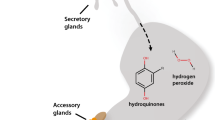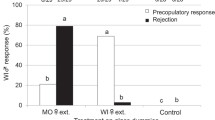Abstract
Female southern house spiders, Kukulcania hibernalis, readily consumed blister beetles, Lytta polita, regardless of cantharidin content when field-tested late in January and again three weeks later in February 1997. In contrast, free-ranging raccoons, Procyon lotor, initially ate many L. polita, particularly female beetles that contained only one third as much cantharidin as males, but when retested the raccoons ate only a few meloids. These results suggest that raccoons, unlike southern house spiders, quickly form an aversion to blister beetle prey, which is induced by cantharidin. Chemical analyses revealed that southern house spiders ingested 99% of the cantharidin contained within their prey.
Similar content being viewed by others
REFERENCES
Abrahamson, W. G., Johnson, A. G., Layne, J. N., and Peroni, P. A. 1984. Vegetation of the Archbold Biological Station, Florida: An example of the southern Lake Wales Ridge. Fla. Sci. 47:209-250.
Brower, L. P., and Fink, L. S. 1985. A natural toxic defense system: Cardenolides in butterflies versus birds. Ann. N.Y. Acad. Sci. 443:171-188.
Carrel, J. E., and Eisner, T. 1974. Cantharidin: potent feeding deterrent to insects. Science 183:755-757.
Carrel, J. E., Doom, J. P., and McCormick, J. P. 1985. Quantitative determination of cantharidin in biological materials using capillary gas chromatography with flame ionization detection. J. Chromatogr. 342:411-415.
Carrel, J. E., Wood, J. M., Yang, Z., McCairel, M. H., and Hindman, E. E. 1990. Diet, body water, and hemolymph content in the blister beetle Lytta polita (Coleoptera: Meloidae). Environ. Entomol. 19:1283-1288.
Conover, M. R. 1989. Potential compounds for establishing conditioned food aversions in raccoons. Wildl. Soc. Bull. 17:430-435.
Deyrup, M., Cronin, J. T., and Kurczewski, F. E. 1988. Allochares azureus: An unusual wasp exploits unusual prey (Hymenoptera: Pompilidae; Arachnida: Filistatidae). Psyche 95:265-281.
Edwards, G. B. 1983. The southern house spider, Filistata hibernalis Hentz (Araneae: Filistatidae). Fla. Dept. Agric. Consum. Serv. Entomol. Circ. 255:2 pp.
Eisner, T., Conner, J., Carrel, J. E., McCormick, J. P., Slagle, A. J., Gans, C., and O'Reilly, J. C. 1990. Systemic retention of ingested cantharidin by frogs. Chemoecology 1:57-62.
Eldridge, R., and Casida, J. E. 1995. Cantharidin effects on protein phosphatases and the phosphorylation state of phosphoproteins in mice. Toxicol. Appl. Pharmacol. 130:95-100.
Frutos, P., Duncan, A. J., Kyriazakis, I., and Gordon, I. J. 1997. Learned aversion towards oxalic acid-containing foods by goats: Does rumen adaptation to oxalic acid influence diet choice? J. Chem. Ecol. 24:383-397.
Galef, B. G., Jr. 1988. Imitation in animals: history, definition, and interpretation of data from the psychological laboratory, pp. 3-28, in T. R. Zentall and B. G. Galef, Jr. (eds.) Social Learning—Psychological and Biological Perspectives. Lawrence Erlbaum Assoc., Hillsdale, New Jersey.
Garcia, J., and Riley, A. L. 1998. Conditioned taste aversions, pp. 549-561, in G. Greenberg and M. M. Haraway (eds.). Comparative Psychology, A Handbook. Garland Publishing, New York.
Johnson, A. S. 1970. Biology of the raccoon (Procyon lotor varius Nelson and Goldman) in Alabama. Auburn Univ. Agric. Exp. Stn. Bull. 402:148 pp.
Keh, B. 1985. Scope and applications of forensic entomology. Annu. Rev. Entomol. 30:137-154.
Kyriazakis, I., Papachristou, T. G., Duncan, A. J., and Gordon, I. J. 1997. Mild conditioned food aversions developed by sheep towards flavors associated with plant secondary compounds. J. Chem. Ecol. 23:727-746.
Liu, X.-H., Blazsek, I., Comisso, M., Legras, S., Marion, S., Quittet, P., Anjo, A., Wang, G.-S., and Misset, J. L. 1995. Effects of norcantharidin, a protein phosphatase type-2A inhibitor, on the growth of normal and malignant haemopoietic cells. Eur. J. Cancer 31A:953-963.
McCormick, J. P., and Carrel, J. E. 1987. Cantharidin biosynthesis and function in meloid beetles, pp. 307-359, in G. D. Prestwich and G. J. Blomquist (eds.). Pheromone Biochemistry, Academic Press, London.
Schmitz, D. G. 1989. Cantharidin toxicosis in horses. J. Vet. Intern. Med. 3:208-215.
Simone, D. A., Hanson, M. E., Bernau, N. A., and Pubols, B. H., Jr. 1993. Nociceptive neurons of the raccoon lateral thalamus. J. Neurophysiol. 69:318-328.
Smedley, S. R., Blankespoor, C. L., Yuang, Y., Carrel, J. E., and Eisner, T. 1996. Predatory response of spiders to blister beetles (family Meloidae). Zoology 99:211-217.
Till, J. S., and Majmudar, B. N. 1981. Cantharidin poisoning. South. Med. J. 74:444-447.
Wang, G.-S. 1989. Medical uses of Mylabris in ancient China and recent studies. J. Ethnopharmacol. 26:147-162.
Yosef, R., Carrel, J. E., and Eisner, T. 1996. Contrasting reactions of loggerhead shrikes to two types of chemically defended insect prey. J. Chem. Ecol. 22:173-181.
Author information
Authors and Affiliations
Rights and permissions
About this article
Cite this article
Carrel, J.E. Contrasting Responses of Southern House Spiders and Raccoons to Blister Beetle Prey. J Chem Ecol 25, 1295–1303 (1999). https://doi.org/10.1023/A:1020970624529
Issue Date:
DOI: https://doi.org/10.1023/A:1020970624529




